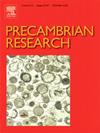奥陶系岩浆从核心到外围的不同置换及其影响:印度南部花岗岩地形的一个实例
IF 3.2
2区 地球科学
Q2 GEOSCIENCES, MULTIDISCIPLINARY
引用次数: 0
摘要
本文章由计算机程序翻译,如有差异,请以英文原文为准。
Differential core-to-periphery emplacement of mafic magma in an Archean Complex and its implications: An example from Southern Granulite Terrain, India
An integrated study on the structure, petrology, mineral chemistry, bulk-rock geochemistry, in-situ garnet geochemistry and emplacement mechanisms of a mafic intrusion is presented from the southern granulite terrain of southern India.
Field study, modal mineralogy and bulk-rock geochemistry characterize the mafic intrusion as hornblende-gabbro to dioritic-gabbro. Structural relationships indicate that the intrusions followed the pre-existing foliations of the rocks of the Bhavani Gneissic Complex. Velocity modelling indicates that the outer zone (periphery), with relatively less viscosity, intruded at a faster rate than the more viscous inner zone (core) resulting in shearing along the core-periphery boundary that led to the development of foliation with appropriate shear sense indicators. The foliation gradually disappears when mapped from the periphery zone of the intrusion towards the core, indicating that the shearing is restricted to the peripheral zone of the intrusion. Absence of intracrystalline deformation of the mineral grains in the foliated periphery zone suggests melt-assisted (magmatic) origin for the foliation in the periphery during emplacement. The orientations of the foliations in the host rocks and along the periphery of the intrusion indicate that the emplacement was syn-to-post kinematic, in the form of an inclined plug within the rocks of the Bhavani Gneissic complex.
Geochemical data show compositional variations in the periphery and core of the intrusion. Bulk-rock geochemical data and in-situ mineral chemistry reveal that parental magma had a tholeiitic affinity in the arc-subduction zone tectonic setting with garnet in its source. The nearly flat chondrite-normalised REE pattern with a mild negative Eu-anomaly and low CaO, and Al2O3 content in the rock, suggests the removal of plagioclase from basic parental magma. Trace element compositions indicate that garnet contains variable amounts of Ni, Cr, Ti, and Co from core to periphery of the intrusion and shows a negative Europium anomaly. Such variations may be due to the initial fluid flow and appropriate fO2 condition, leading to magnetite precipitation, which incorporated Ni, Ti, Cr and Co. In general, a higher concentration of Ni and Cr in the core of the intrusion than the periphery, suggests that the core may be explored for Ni-Cr and PGE potential.
求助全文
通过发布文献求助,成功后即可免费获取论文全文。
去求助
来源期刊

Precambrian Research
地学-地球科学综合
CiteScore
7.20
自引率
28.90%
发文量
325
审稿时长
12 months
期刊介绍:
Precambrian Research publishes studies on all aspects of the early stages of the composition, structure and evolution of the Earth and its planetary neighbours. With a focus on process-oriented and comparative studies, it covers, but is not restricted to, subjects such as:
(1) Chemical, biological, biochemical and cosmochemical evolution; the origin of life; the evolution of the oceans and atmosphere; the early fossil record; palaeobiology;
(2) Geochronology and isotope and elemental geochemistry;
(3) Precambrian mineral deposits;
(4) Geophysical aspects of the early Earth and Precambrian terrains;
(5) Nature, formation and evolution of the Precambrian lithosphere and mantle including magmatic, depositional, metamorphic and tectonic processes.
In addition, the editors particularly welcome integrated process-oriented studies that involve a combination of the above fields and comparative studies that demonstrate the effect of Precambrian evolution on Phanerozoic earth system processes.
Regional and localised studies of Precambrian phenomena are considered appropriate only when the detail and quality allow illustration of a wider process, or when significant gaps in basic knowledge of a particular area can be filled.
 求助内容:
求助内容: 应助结果提醒方式:
应助结果提醒方式:


